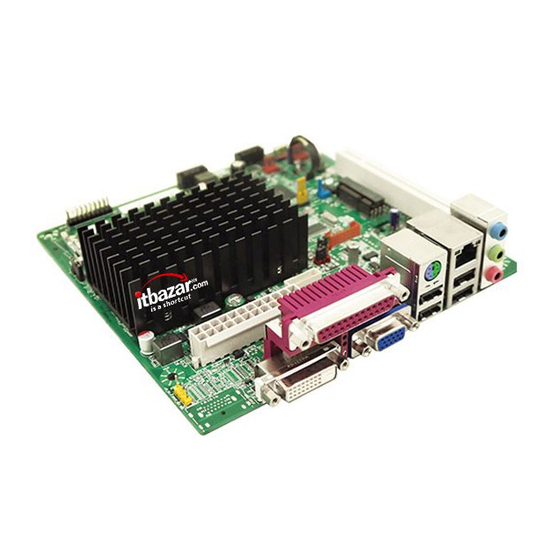
Advertisement
Table of Contents
- 1 Desktop Board Features
- 2 Desktop Board Components
- 3 System Memory
- 4 Connecting to the Internal Headers
- 5 Updating the BIOS
- 6 Updating the BIOS Using the F7 Function Key
- 7 Recovering the BIOS
- 8 A Board Status and Error Messages
- 9 Bios Beep Codes
- 10 BIOS Front-Panel Power LED Blink Codes
- 11 POST Error Messages
- 12 Battery Caution
- Download this manual
Advertisement
Table of Contents

Subscribe to Our Youtube Channel
Summary of Contents for MiTAC PD10TI
- Page 1 MITAC Desktop Board PD10TI Product Guide...
-
Page 2: Desktop Board Features
Desktop Board Features This chapter briefly describes the main features of MITAC Desktop Board PD10TI. Table 1 summarizes the features of the Desktop Board. 1. F ABLE EATURE UMMARY Form Factor Mini-ITX (170 millimeters [6.7 inches] x 170 millimeters [6.7 inches]) Processor Passively-cooled, soldered-down dual-core Intel®... - Page 3 Table 1. Feature Sum mar y (continued) LAN Support Intel® 82574L Gigabit (10/100/1000 Mb/s) Ethernet LAN controller BIOS Support for Advanced Configuration and Power Interface (ACPI), Plug and Play, and SMBIOS Instantly Available Support for Advanced Configuration and Power Interface (ACPI) PC Technology Wake on USB, PCI, PCI Express, LAN, serial, PS/2, and front panel...
-
Page 4: Desktop Board Components
Desktop Board Components Figure 1 shows the location of the major components on MiTAC Desktop Board PD10TI. 1. M TAC D PD10TI C IGURE ESKTOP OARD OMPONENTS... - Page 5 2. M TAC D PD10TI C ABLE ESKTOP OARD OMPONENTS Label Description Back panel connectors S/PDIF out header Standby power indicator Main power connector (2 x 12 pin) Flat panel voltage selection header LVDS interface connector Processor TPM header SO-DIMM 1 slot...
-
Page 6: System Memory
Processor MiTAC Desktop Board PD10TI includes a passively-cooled, dual-core Intel Atom processor with integrated graphics and memory controller. The processor is soldered to the Desktop Board and is not customer upgradeable. NOTE The board is designed to be passively cooled in a properly ventilated chassis. Chassis venting locations are recommended above the processor heatsink area for maximum heat dissipation effectiveness. -
Page 7: Connecting To The Internal Headers
Connecting to the Internal Headers Figure 2. Internal Headers... -
Page 8: Updating The Bios
Updating the BIOS The BIOS Setup program can be used to view and change the BIOS settings for the computer. You can access the BIOS Setup program by pressing the <F2> key after the Power-On Self-Test (POST) memory test begins and before the operating system boot begins. -
Page 9: Updating The Bios Using The F7 Function Key
Updating the BIOS Using the F7 Function Key To use this BIOS update method: 1. Download and save the Recovery BIOS (.BIO) file to a temporary directory. 2. Copy the .BIO file to a USB thumb drive. 3. Plug the thumb drive into a USB port of the target computer. 4. -
Page 10: Recovering The Bios
NOTE Review the instructions distributed with the update utility before attempting a BIOS update. CAUTION Do not interrupt the process or the system may not function properly. Uncompress the BIOS update file and copy the .BIO file, to a bootable USB flash drive or other bootable USB media. -
Page 11: A Board Status And Error Messages
A Board Status and Error Messages This appendix describes status and error messages generated by the Desktop Board’s BIOS. The BIOS indicates these error messages with front-panel Power LED blink codes, speaker beep codes, and by displaying text on the video monitor. BIOS Beep Codes The BIOS uses audible beep codes to signal status messages and error messages indicating recoverable errors that occur during the POST. -
Page 12: Bios Front-Panel Power Led Blink Codes
BIOS Front-panel Power LED Blink Codes The BIOS also blinks the front-panel power LED to signal status messages and error messages indicating certain recoverable errors that occur during the POST. The blink codes are listed in Table 18. 4. BIOS F LED B ABLE RONT... -
Page 13: Battery Caution
A suitable caution label is included with MiTAC Desktop Board PD10TI. CAUTION Risk of explosion if the battery is replaced with an incorrect type. Batteries should be recycled where possible.
















Need help?
Do you have a question about the PD10TI and is the answer not in the manual?
Questions and answers